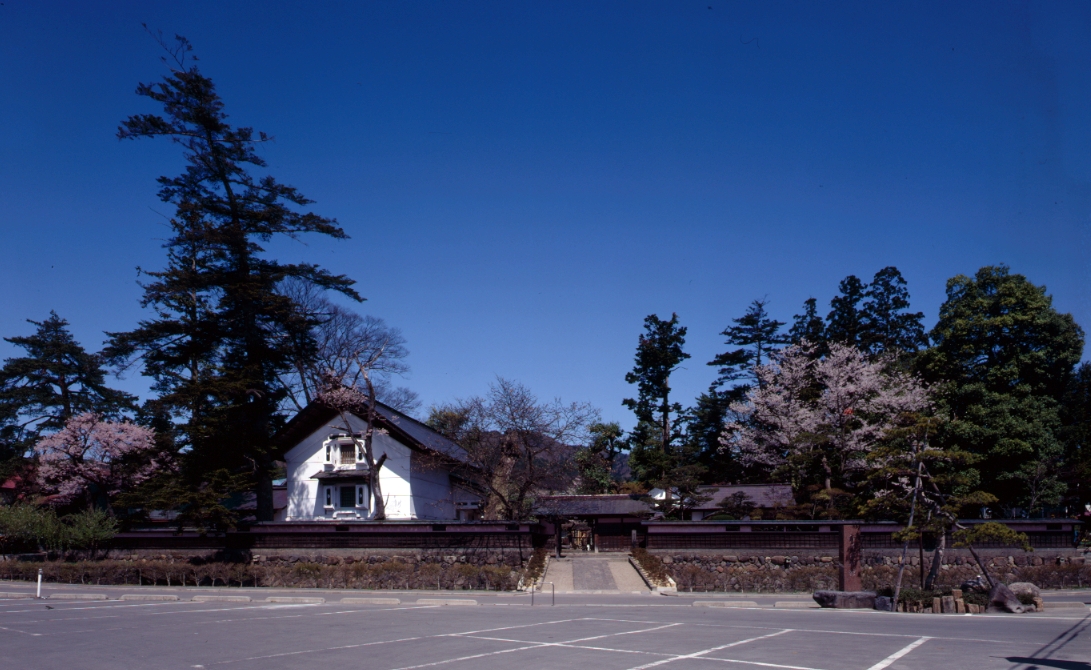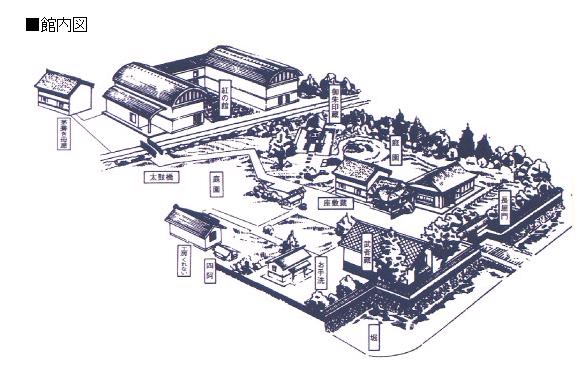The Benibana Museum (The Safflower Museum)
2. From the Horigome Residence of a Wealthy Farmer to the Museum
(豪農堀米邸から資料館へ)
This Benibana Museum was once the residence of Shirobe Horigome (堀米四郎兵衛) - a wealthy farmer around this area in Edo period. The total of the farm land was about 80 ares of the land and the residence had 6 warehouses and 7 wood-made warehouses. But, up to now, the most of the warehouses and the dwellings were withdrawn because of their advanced ages. But even now about five thousands of stuffs of the weapons and life necessities and old documents were preserved. In 1982 after the Town was donated these historic stuffs and properties, they restored and consolidated them in a good order. The Town opened them as "the Benibana Museum" in May, 1984.
The Horigomes began to built its fortunes to purchase the farm lands around the area about Genroku (元禄) <1688-1703> in Edo period and took the role of the headman of a village. During these periods, they dealt the buying and selling of rice, aoso (青苧) and benibana. Especially, benibana was increasingly dealt in Bunka (文化) <1804-1818> and grew up the status of this family as one of the richest one in Kahoku Town. The fortunes accumulated through the ages was partly used for the land developing and a financial capital to loan money to some of the Daimyos (大名). This is proved by the fact that this families preserved the some valuable stuffs that were sent by the Date Clan (伊達藩) who was the land lord of Shiroishi (白石城主). At the end of Edo period, the total capitals of the Horigomes were approximately 60 hectares farm lands and 100 hectares wood forests and 8,500 ryos for loan. The family had, at that ages, 20 servants and 200 peasants. This proved the Horigomes was one of the upper class farmers around the area.
The remarkable achievement of the family was the support and practice of the farmers' system of military action at the end of Edo period. In 1863, when the society of Japan was thrown into the political confusion, the Shogunate (幕府) gave an order to conscript to rich farmers of the country. Receiving this order, Shirobei, the sixth owner of the family, promptly made the system of conscription prior to the other parts of Tohoku areas.
The arms' warehouse (武器庫) contains various weapons the family accumulated. During five years since 1863, 7 cannons, various weapons and armors were kept in storage. When the end of old political power came close, the Horigomes didn't show its color for and against both the governments. So the cannons and armors there were confiscated by both armies - the Sakai Clan of Shonai (庄内・酒井藩) and the Imperial Army (官軍). The latter even arrested Shirobei as their enemy. But soon after that, he was released and changed his name Minoru Horigome (堀米実) . He became the member of a prefectural assembly and later he was appointed its vice president. Thereafter, Yasutaro (康太郎), the eighth owner of the family, moved his house to Tokyo to promote the children's education. Kohei (耕平), his eldest son, graduated from Waseda University, the second and third son, Teiji (悌二) and Yozo (庸三), graduated from Tokyo University and the eldest daughter, Miho (美穂), graduated from the Ochanomizu University. The fourth son, Tetsuya (鉄也), graduated from Keio University. Yuzuko (ゆず子), who is a daughter of Tetsuya, is a famous violinist.
Goshuin-gura (御朱印蔵) was built in the wide and the most calm corner of the garden surrounded by the moat. As the name shows as it is, this house is the container of the authorized document published by the Shogunate government. This house is constructed of godown and styled in Irimoya (入母屋造). The master builder was Jinsaku Matsuda (松田仁作) and the planning and the wood carving was in charge of Tokichi Hosoya (細谷藤吉), the statue of a lion was carved by Bungoro Takayama (高山文五郎). Bungoro was a distinguished wood carver who made the carvings of Sojiji Temple (総持寺) in Noto (能登) with his son Tomishige (富重). The level of the techniques of carving of Yachi (谷地) was highly proud of at that age. But generally, most of the Goshuin-guras were destroyed when the Meiji era began, because those were the symbol of the Shogunate rule. Fortunately, that of Kahoku Town like these got rid of destruction because the place was so remote from the capital. To make the matter lucky, the authorized document was misaddressed so that the Imperial Army took it unimportant. The house is the only one Goshuin-gura that is preserved and it is said that the house is very valuable all over this country. But the house is not designated as the important cultural national treasure, because it was remodelled when it was restored.
The main building in the residence had once a thatched roof and it was bigger - 29 meters wide in front and had more than 15 rooms. But the present one was made its size smaller. The main room called Zashiki-gura (座敷蔵) was built as a closet, which was one of the oldest styled room at the middle of Edo period in this Town. The room was restored at the head of Meiji era and the carvings of a crane and a tortoise are decorated in the alcove. The pictures of fusuma (襖) was painted by Shinsai (縉斎) who was a painter of the Date Clan (伊達藩) in 1854. The picture of the backside of a shutter box was put a gold foil and its pillar was equipped with a peel of wood. The whole of the room is luxurious in an invisible parts. Many of daily accommodations are exhibited to show the daily life of benibana merchants.
At the bottom of the residence, "the Benibana House" was built in 1986 and the process from planting and growing to its merchandising is exhibited there.
The traditional dance, Bugaku (舞楽), which succeeded by the Hayashis (林家) from Heian (平安) period, is dedicated on the 14th and 15th of September every year at the Yachi Hachimangu Shrine (谷地八幡宮). One of the dances, "Ryouou" (陵王) is the most bravest one and the costumes used for dancing are dyed with benibana.
Inside of the Museum, the discrimination of coloring of benibanas is shown. Benibana produces both red and yellow pigments and these colors are used for red and yellow dyeing. The crimson color becomes thicker and thicker by layering its color. Every coloring spends a cake of lumps of benibana and a deeper red needs ten times' cost if it is done with ten layering process. The color "Ouni" (黄丹) producted with red and yellow dyeing material is used for "Hou" (袍) whose color is adjusted for the ritual costume of the Crown Prince. The cloth duplicated with red and indigo is called "Futaai" (二藍) and is used for a lining of the Emperor's ritual costume, which is forbidden to wear by other people. In Heian period, a roll cloth of a deeper red dyeing was said equal to a residence of noble men. This story tells us that costumes of benibana dyeing was priceless in old days.
By the laser-disc system, "Growing and Merchandizing" "Dyeing Process" and "Yachi Donga Festival" are presented so that the history of benibana and its commercial and trading and its dyeing process are clearly shown respectively. The flower was transported to Oishida (大石田) by horse to get rid of hard routes of the Mogami River (最上川). A horse usually conveyed 120 kirograms called "Ichida" (一駄). This was the unit for merchandizing of the flower and cost, at that age, 50 ryos (両) equal to 100 pyos (俵) of rice. The ship conveyed them to Sakata (酒田) by the river and Kitamae-bune (北前船) brought them to Tsuruga (敦賀) from there, and the cargo was carried by land and shipped to Kyoto. It spent almost a full month and the Mogami-benibana which was occupied the 50% of production in this country spread its fame all over Japan.
The ships which conveyed benibana, in its return, brought back various kinds of Kyoto cultural goods and necessities of daily life to flower's native town. The costumes dyed with benibana that were the longing of ladies, lipsticks which colored pretty lips of women, porcelains, Kyoho Dolls (享保雛), Kokin Dolls (古今雛) and Takeda Dolls (竹田雛), Gosho Dolls (御所人形) have been preserved their lives in the remote Tohoku (Michinoku) country and they resumes their reopening stage in revival light.

